from Apr. 19, 1865
The National Grief
-
Full Title
The National Grief
-
Transcription
"The chill that was cast over the public heart on the reception of the news of the death of President Lincoln, has been dissipated by the warm gushing forth of sorrow, and earnest and heartfelt manifestations of deep seated grief. The first feelings of bitter anger and revengeful desires have not been forgotten nor have they been eradicated..."
-
Source
McLean County Museum of History
-
Rights
Creative Commons Attribution-NonCommercial-ShareAlike (CC-BY-NC-SA)
-
Tags
-
Cite this Item
The Pantagraph. "The National Grief". Remembering Lincoln. Web. Accessed December 16, 2025. https://rememberinglincoln.fords.org/node/722
from Apr. 19, 1865
The National Grief
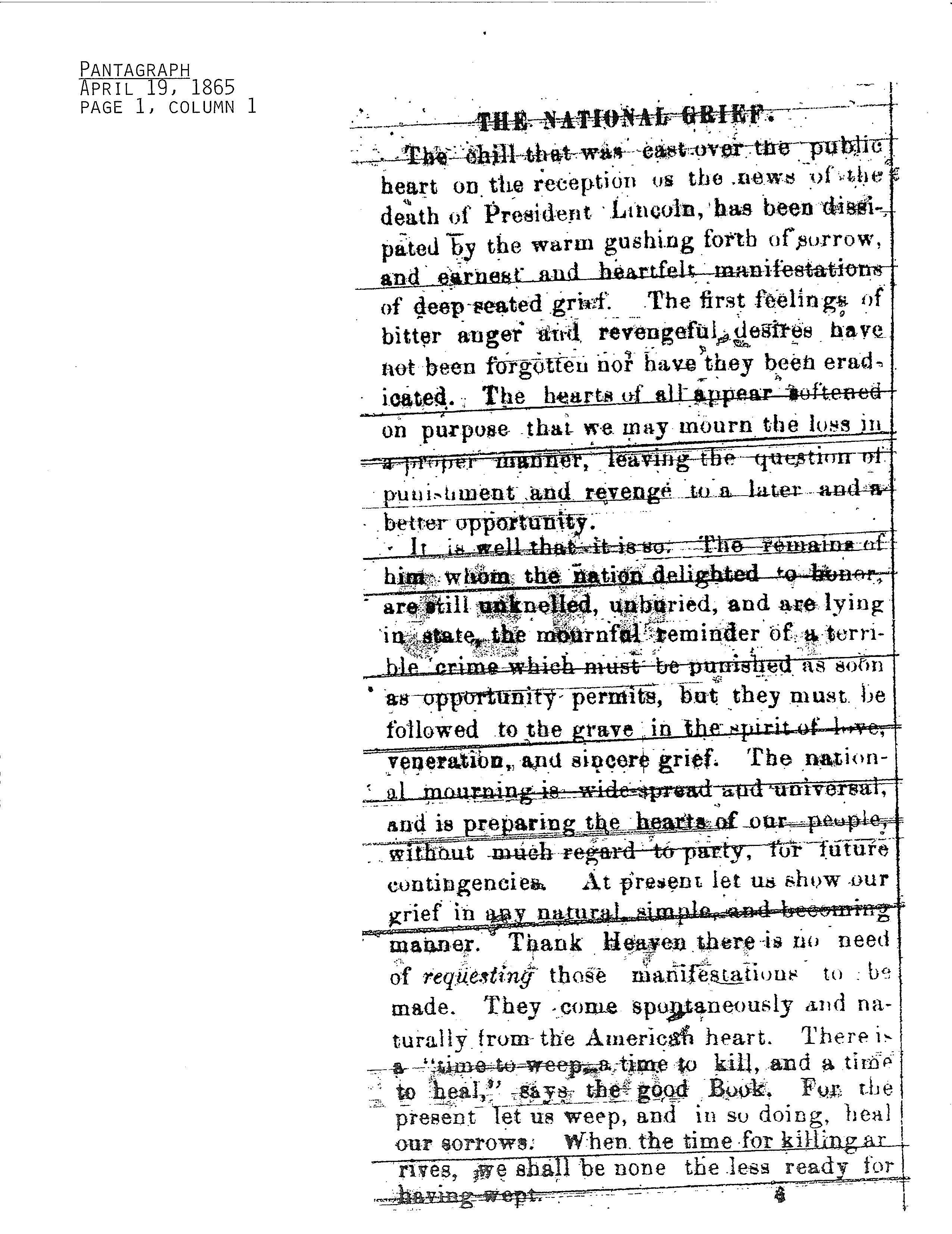
-
Source
McLean County Museum of History
-
Rights
Creative Commons Attribution-NonCommercial-ShareAlike (CC-BY-NC-SA)
-
Creator
The Pantagraph
-
Date
April 19, 1865
from Apr. 25, 1865
Appropriate Ceremonies
-
Full Title
Appropriate Ceremonies
-
Transcription
"Cheney's Grove, April 20th, 1865 - Ed. Pantagraph -- According to previous arrangement the people of this community met on yesterday morning at the residence of Willis Rowe for purpose of forming a funeral procession in token of our respect for the memory of Abraham Lincoln. The procession was formed by Lieut. S. R. Riggs assisted by H. P. Lowry and was as follows: 1st, The Goddess of Liberty draped in mourning, represented by Mrs. S. R. Riggs. 2nd, The national flag at half mast also in mourning. 3d, Thirty-five young ladies on horseback dressed in black. 4th, A company of soldiers in uniform. 5th, Martial music. After these was a large number of persons in carriages, wagons, and on horse back. The procession then proceeded to the new Church in Saybrook, where an eloquent and touching discourse was delivered by Rev. C. G. Bradshaw..."
-
Source
McLean County Museum of History
-
Rights
Creative Commons Attribution-NonCommercial-ShareAlike (CC-BY-NC-SA)
-
Tags
-
Cite this Item
The Pantagraph. "Appropriate Ceremonies". Remembering Lincoln. Web. Accessed December 16, 2025. https://rememberinglincoln.fords.org/node/721
from Apr. 25, 1865
Appropriate Ceremonies
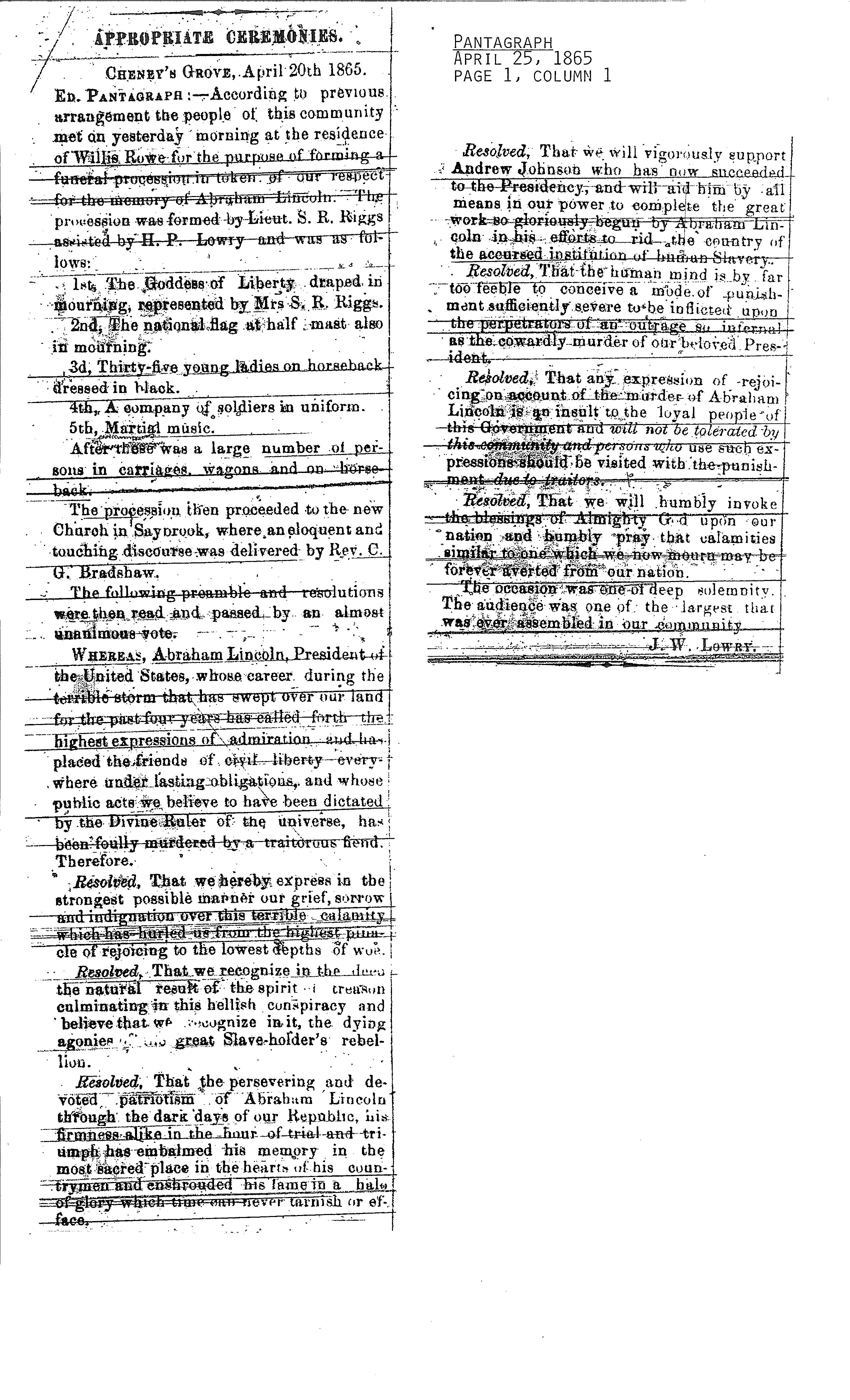
-
Source
McLean County Museum of History
-
Rights
Creative Commons Attribution-NonCommercial-ShareAlike (CC-BY-NC-SA)
-
Creator
The Pantagraph
-
Date
April 25, 1865
from Feb. 12, 1942
Rose Whipp Northrup Reminiscence
-
Full Title
Rose Whipp Northrup Reminiscence
-
Transcription
SUPERNATURAL VISIT WITH FRIEND?
Mrs. Northrup Recalls Vision of Lincoln at His Old Desk
Trip to Office in Springfield Inspires ‘Sight’
“Mother! Look at that desk. Do you see the long legs resting on the desk, and the tall, dark man lean-ing back in his chair?”
“Why, daughter-I see the desk. That was Abraham Lincoln’s desk. But there are no long legs now resting on the desk, nor any tall man leaning back in the chair.”
Supernatural? A spirit pheno-menon?
“It was so vivid, so startling, that it seemed supernatural to me,” said Mrs. Rose Northrup, aged 91 as she recalled in Mennonite hos-pital Monday this “vision” of Abraham Lincoln, whom she had known as a kind friend many years before.
Revisited Room
The “vision” had been an actuality in the childhood of Rose Whipp, later Mrs. Northrup, for when she was 7 years old she had often seen Lincoln’s long legs on his desk, had seen the tall, dark man leaning back in his chair.
When Rose years later, with her mother, revisited the little room where the famous desk still stood, instantly the specter figure of Lin-coln appeared, so real that she now says it was “supernatural,” and she had difficulty in trying to make her mother “see” what she as a child had so often actually seen.
Mrs. Northrup, who has been a patient, at Mennonite hospital since last September, forgot her in-firmity for the moment-forgot the years which have burdened her frail body, as she talked in animat-ed vigor of the memories which grew from her girlhood friendship with the Lincoln family and chiefly with the great man and afterward martyred President.
Lived in Same Block.
Rose Whipp is a daughter of John W. Whipp of Bloomington, who got a job as assistant state treasurer in the 50’s and had moved his family to Springfield. There the Whipps and the Lin-colns lived in houses in the same block. Mr. Whipp worked in the state house, where Lincoln spent much time. Rose ran in and out of his office as if she were his own child. Lincoln often took Rose on his lap, stroked her blond locks and called her “silverhair.”
But not all memories of Mrs. Northrup connected with Lincoln are pleasant ones. Some were ex-tremely sad-some tragic.
For instance, when the Whipp family had moved back to Bloom-ington and the “tall, dark man” had become President.
Rose returned to her home one morning and found her mother in anguished tears.
Swear Vengeance.
“What’s the matter, mother?” she asked.
“Oh, they have assassinated our dear President,” the mother an-swered.
Then mother and daughter start-ed down the street toward the courthouse. Hundreds of others were streaming in the same direction. At the public square a great crowd had gathered and men were making speeches,
“And many men were cursing and swearing vengeance on the perpetrators of the awful murder of Lincoln,” said Mrs. Northrup. Mother and daughter stood around downtown until the indignation meeting had ended. A picture of that gathering is one of the historic scene of local history.
Clear memory of Past.
Then there was the time, Mrs. Northrup recalls, when she went with her father and uncle to at-tend funeral services for Lincoln at Springfield.
The town was one of vast mourning assemblage. Bands played dirges and familiar hymns. Flags and mourning emblems hung from all the buildings. “Come Ye Discon-solate,” and “Peace, Troubled Soul,” were two of the tunes oftenmost played, Mrs. Northrup recalls.
Mrs. Northrup has a remarkably clear memory of the past; not alone for those memorable days when she played in the office of Lincoln, but for many other years in which Springfield and Bloomington history have enriched her life.
She celebrated her 91st birthday in the hospital last September, when nurses and visiting friends gave her a real party, which she speaks of as one of the happy events of her recent life.
[Transcription by Alicia B., Ford's Theatre Society.] -
Rights
Creative Commons Attribution-NonCommercial-ShareAlike (CC-BY-NC-SA)
-
Tags
-
Cite this Item
The Pantagraph. "Rose Whipp Northrup Reminiscence ". The Pantagraph. Remembering Lincoln. Web. Accessed December 16, 2025. https://rememberinglincoln.fords.org/node/720
from Feb. 12, 1942
Rose Whipp Northrup Reminiscence
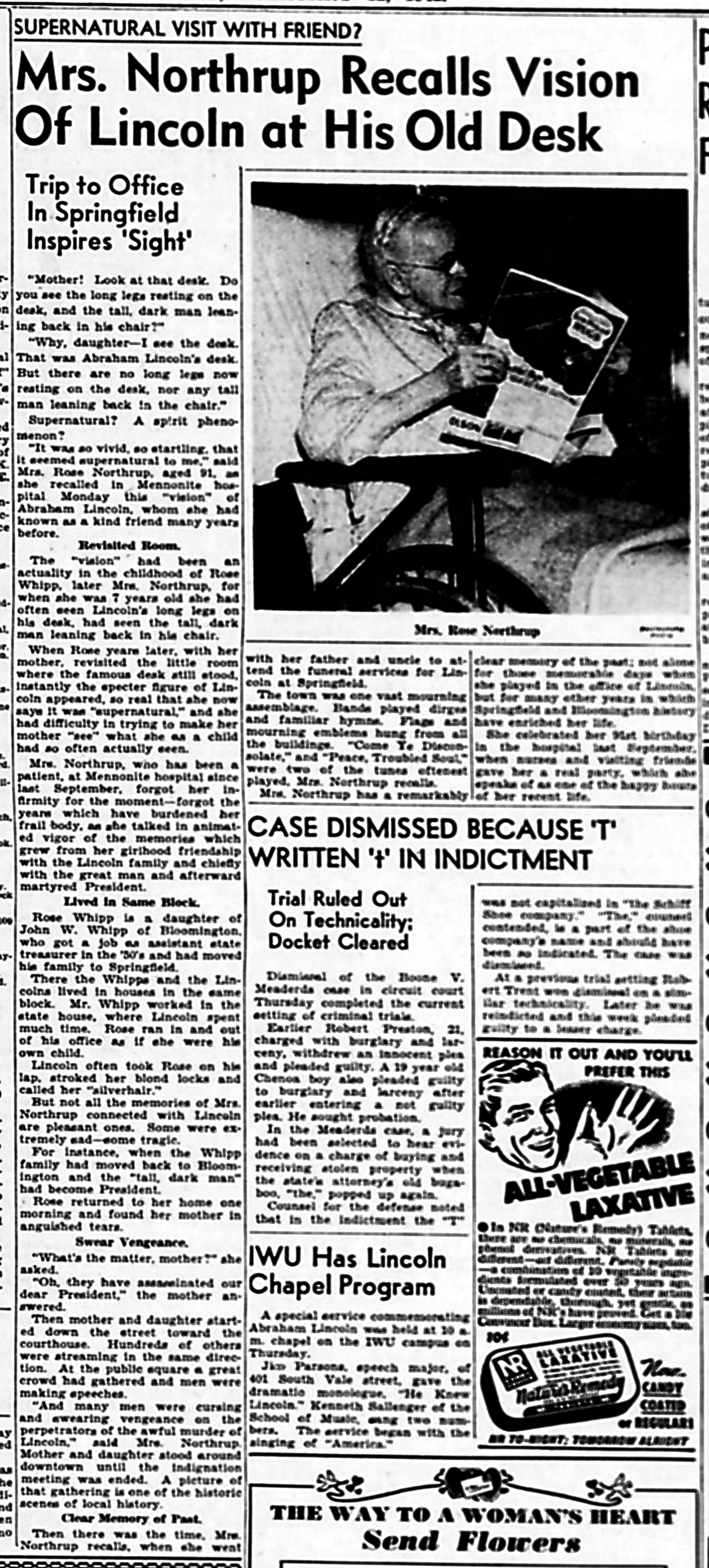
-
Rights
Creative Commons Attribution-NonCommercial-ShareAlike (CC-BY-NC-SA)
-
Creator
The Pantagraph
-
Publisher
The Pantagraph
-
Date
February 12, 1942
from
Ceremonies of the Funeral
-
Full Title
Ceremonies of the Funeral
-
Transcription
"CEREMONIES OF THE FUNERAL and views of the remains of our late president while lying in state at Springfield" "SPECIAL PASSENGER TRAINS will be run on Wednesday May 3d, and Thursday, May 4th as follows"
-
Source
McLean County Museum of History
-
Rights
Creative Commons Attribution-NonCommercial-ShareAlike (CC-BY-NC-SA)
-
Tags
-
Cite this Item
Unknown. "Ceremonies of the Funeral". Remembering Lincoln. Web. Accessed December 16, 2025. https://rememberinglincoln.fords.org/node/719
from
Ceremonies of the Funeral
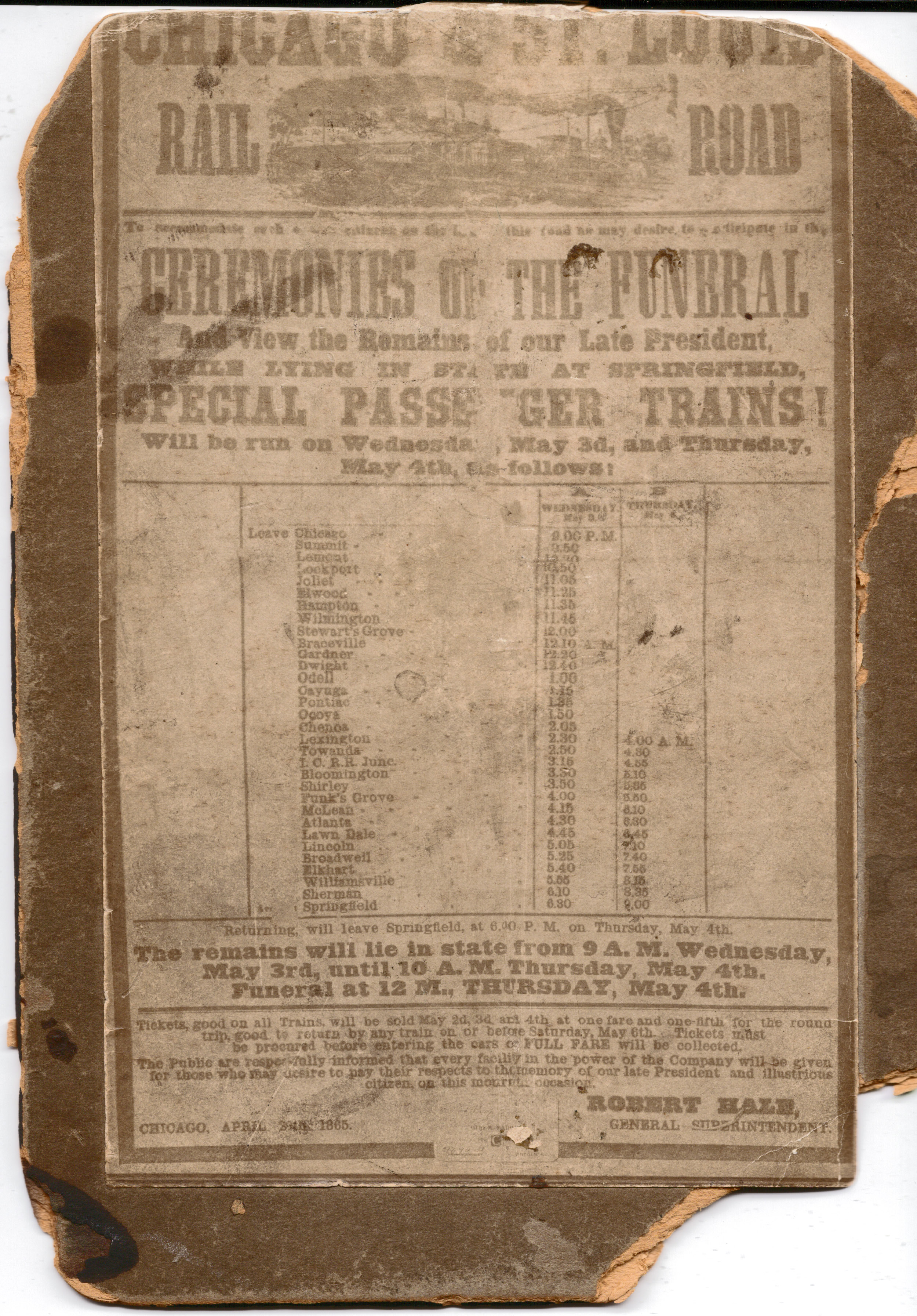
-
Source
McLean County Museum of History
-
Rights
Creative Commons Attribution-NonCommercial-ShareAlike (CC-BY-NC-SA)
-
Creator
Unknown
from
Funeral Car
-
Full Title
Funeral Car
-
Description
The funeral train—or cortege, as it was called—left Washington, D.C. on April 21, taking a circuitous route through 15 states and some 180 towns and cities, including New York, Cleveland, and Indianapolis. With the exception of the president’s car, which carried Lincoln’s body, the others changed frequently as the train moved from one railroad line to the other. The president’s car was built at the Military Railroad System shop in Alexandria, Virginia
-
Rights
Creative Commons Attribution-NonCommercial-ShareAlike (CC-BY-NC-SA)
-
Cite this Item
Unknown. "Funeral Car". Remembering Lincoln. Web. Accessed December 16, 2025. https://rememberinglincoln.fords.org/node/718
from
Funeral Car
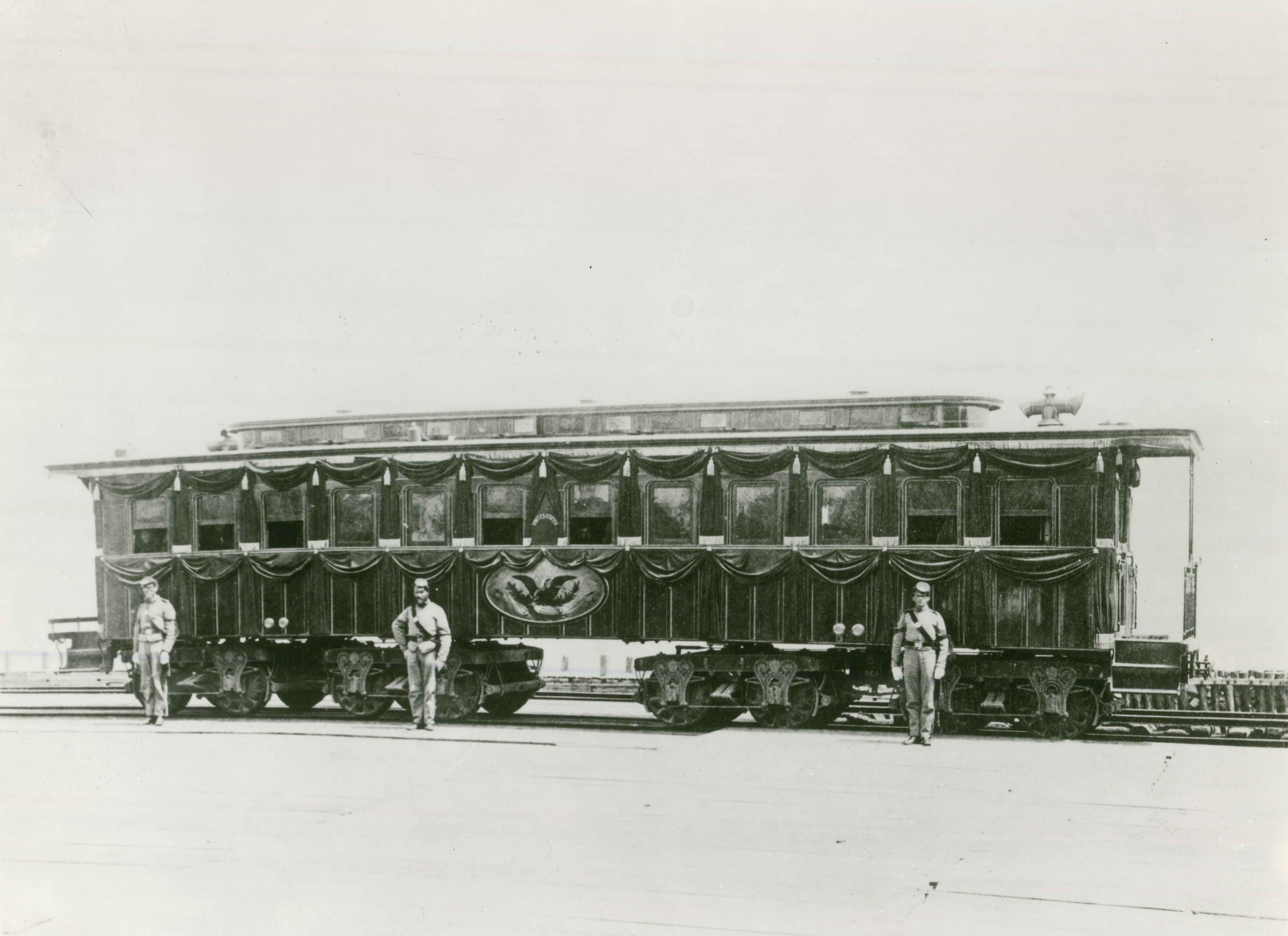
-
Description
The funeral train—or cortege, as it was called—left Washington, D.C. on April 21, taking a circuitous route through 15 states and some 180 towns and cities, including New York, Cleveland, and Indianapolis. With the exception of the president’s car, which carried Lincoln’s body, the others changed frequently as the train moved from one railroad line to the other. The president’s car was built at the Military Railroad System shop in Alexandria, Virginia
-
Rights
Creative Commons Attribution-NonCommercial-ShareAlike (CC-BY-NC-SA)
-
Creator
Unknown
from Apr. 14, 2015
Funeral
-
Full Title
Funeral
-
Source
McLean County Museum of History
-
Rights
Creative Commons Attribution-NonCommercial-ShareAlike (CC-BY-NC-SA)
-
Cite this Item
Unknown. "Funeral". Remembering Lincoln. Web. Accessed December 16, 2025. https://rememberinglincoln.fords.org/node/717
from Apr. 14, 2015
Funeral
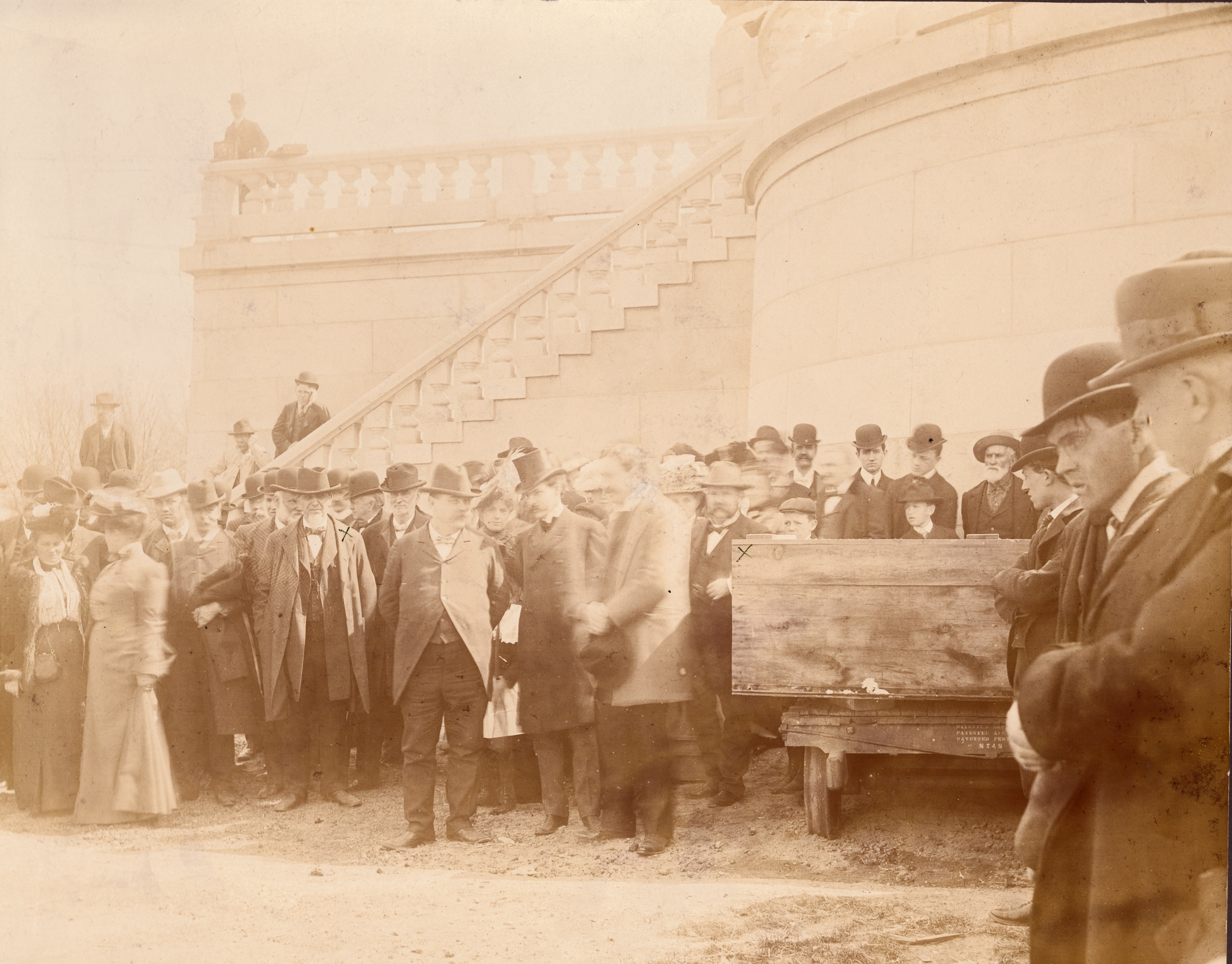
-
Source
McLean County Museum of History
-
Rights
Creative Commons Attribution-NonCommercial-ShareAlike (CC-BY-NC-SA)
-
Creator
Unknown
-
Date
April 14, 2015
from May. 1, 1865
Funeral Arch in Chicago
-
Full Title
Funeral Arch in Chicago
-
Source
McLean County Museum of History
-
Rights
Creative Commons Attribution-NonCommercial-ShareAlike (CC-BY-NC-SA)
-
Cite this Item
Unknown. "Funeral Arch in Chicago". Remembering Lincoln. Web. Accessed December 16, 2025. https://rememberinglincoln.fords.org/node/716
from May. 1, 1865
Funeral Arch in Chicago
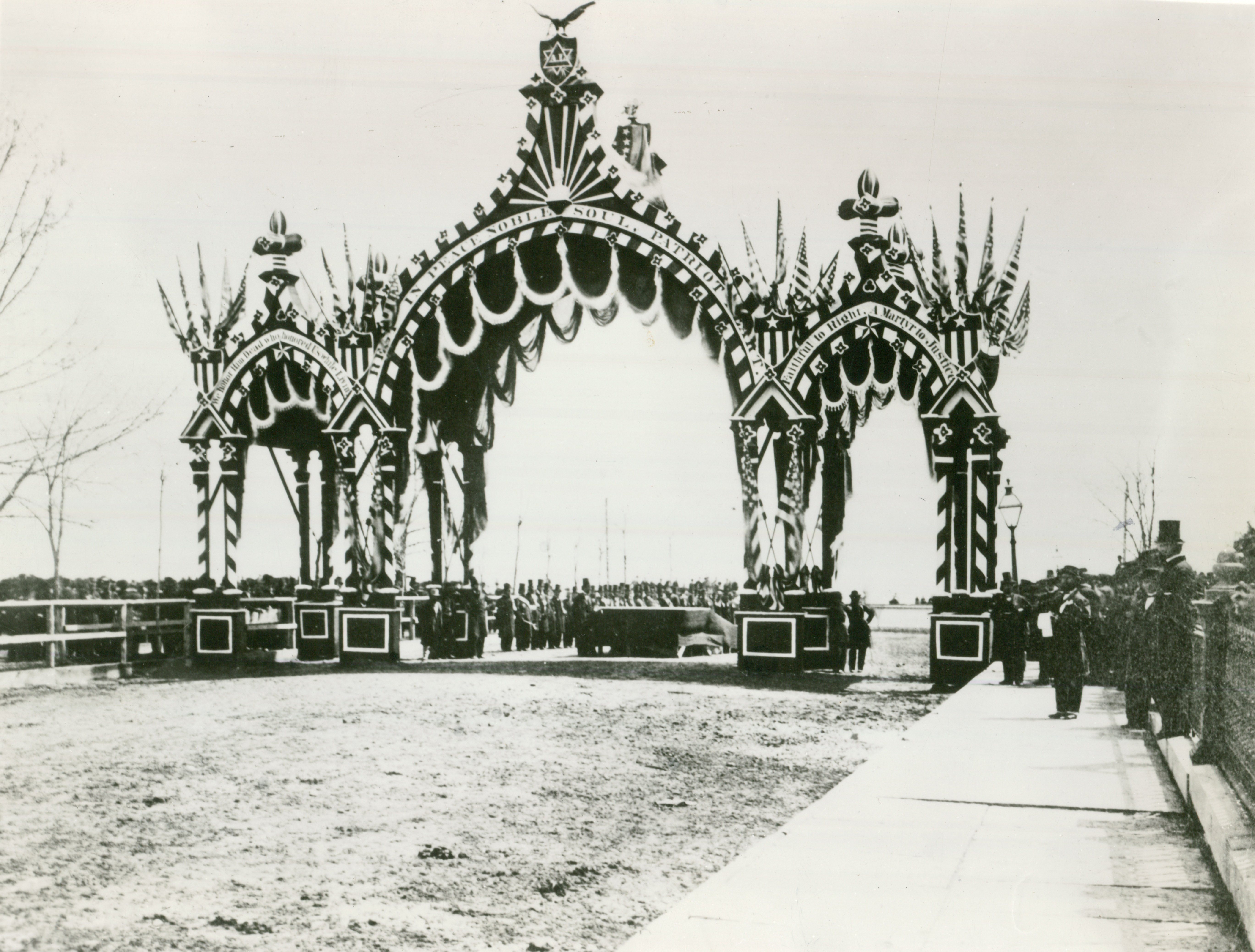
-
Source
McLean County Museum of History
-
Rights
Creative Commons Attribution-NonCommercial-ShareAlike (CC-BY-NC-SA)
-
Creator
Unknown
-
Date
May 1, 1865
from May. 1, 1865
Funeral Arch
-
Full Title
Funeral Arch
-
Source
McLean County Museum of History
-
Rights
Creative Commons Attribution-NonCommercial-ShareAlike (CC-BY-NC-SA)
-
Cite this Item
Unknown. "Funeral Arch". Remembering Lincoln. Web. Accessed December 16, 2025. https://rememberinglincoln.fords.org/node/715
from May. 1, 1865
Funeral Arch

-
Source
McLean County Museum of History
-
Rights
Creative Commons Attribution-NonCommercial-ShareAlike (CC-BY-NC-SA)
-
Creator
Unknown
-
Date
May 1, 1865
from
Lincoln Funeral Train- Chicago at Lake Michigan
-
Full Title
Lincoln Funeral Train- Chicago at Lake Michigan
-
Description
One of the best accounts of the Chicago-to-Springfield journey comes from Chicago & Alton brakeman William S. Porter, who was part of conductor George Hewitt’s crew. “As I remember the funeral train,” Porter wrote in 1917, “it consisted of one baggage car, several ordinary coaches and the catafalque car (the one carrying Lincoln’s body), which was the second car from the rear end of the train.”
-
Source
McLean County Museum of History
-
Rights
Creative Commons Attribution-NonCommercial-ShareAlike (CC-BY-NC-SA)
-
Cite this Item
Unknown. "Lincoln Funeral Train- Chicago at Lake Michigan". Remembering Lincoln. Web. Accessed December 16, 2025. https://rememberinglincoln.fords.org/node/714
from
Lincoln Funeral Train- Chicago at Lake Michigan
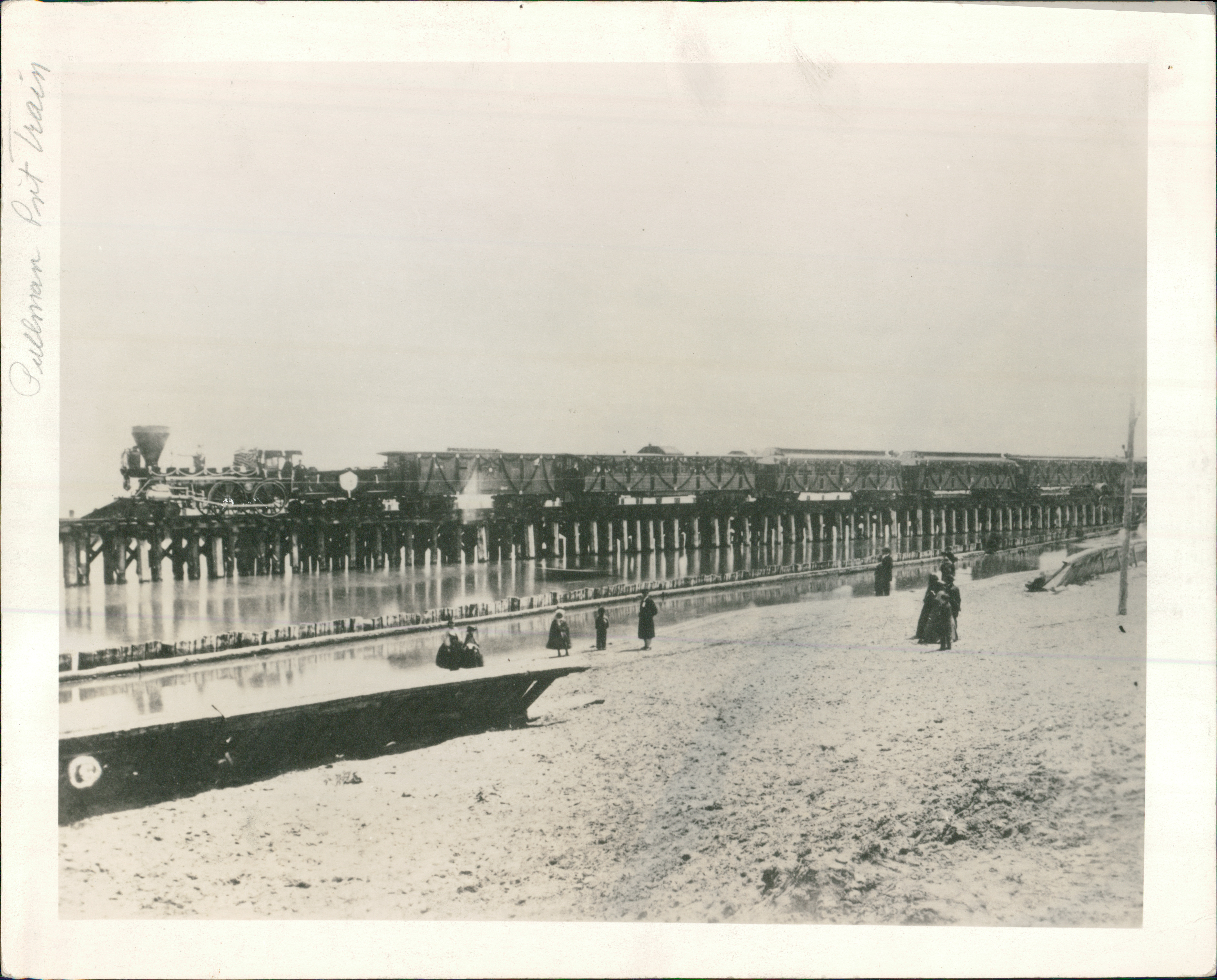
-
Description
One of the best accounts of the Chicago-to-Springfield journey comes from Chicago & Alton brakeman William S. Porter, who was part of conductor George Hewitt’s crew. “As I remember the funeral train,” Porter wrote in 1917, “it consisted of one baggage car, several ordinary coaches and the catafalque car (the one carrying Lincoln’s body), which was the second car from the rear end of the train.”
-
Source
McLean County Museum of History
-
Rights
Creative Commons Attribution-NonCommercial-ShareAlike (CC-BY-NC-SA)
-
Creator
Unknown
from Apr. 18, 1865
"Immense Meeting on Sunday -- A Sabbath Well Spent -- 6,000 People Present"
-
Full Title
"Immense Meeting on Sunday -- A Sabbath Well Spent -- 6,000 People Present"
-
Description
Pantagraph story about how the news arrived, and the indignation meeting on the courthouse square.
-
Transcription
"We have been told that when our dispatch reached Bloomington the news could not at first be believed. More confirmations soon arrived and the dreadful truth was accepted by all. Almost simultaneously houses and stores were draped in heavy mourning, and the entire community was overwhelmed in grief"
-
Rights
Creative Commons Attribution-NonCommercial-ShareAlike (CC-BY-NC-SA)
-
Tags
-
Cite this Item
The Pantagraph. ""Immense Meeting on Sunday -- A Sabbath Well Spent -- 6,000 People Present"". The Pantagraph. Remembering Lincoln. Web. Accessed December 16, 2025. https://rememberinglincoln.fords.org/node/713
from Apr. 18, 1865
"Immense Meeting on Sunday -- A Sabbath Well Spent -- 6,000 People Present"

-
Description
Pantagraph story about how the news arrived, and the indignation meeting on the courthouse square.
-
Rights
Creative Commons Attribution-NonCommercial-ShareAlike (CC-BY-NC-SA)
-
Creator
The Pantagraph
-
Publisher
The Pantagraph
-
Date
April 18, 1865
